On April 9, 1975, the Philippine Basketball Association (PBA) formally opened, making it the first play for pay league in Asia and second in the world after the NBA. Nine franchises made up the original roster featuring teams from the then MICAA, then the leading basketball tournament in the Philippines.
The Rivalry takes a look back as to why and how the PBA was formed 48 years ago.
The background
The Philippines was the toast of Asia after regaining the 7th ABC tournament (FIBA-Asia Cup) held on December, 1973 in Manila. The championship provided the country with a ticket to the 7th World Basketball Championship to be held in San Juan, Puerto Rico, on July, 1974. There was also the 7th Asian Games to be held in Tehran, Iran two months after the world championship.
The organization in charge of forming the national teams was the Basketball Association of the Philippines (BAP), presided by Gonzalo “Lito” Puyat. Prior to the 1973 ABC title conquest, in the 1971 ABC, the Philippines suffered a humiliating 93-69 loss to the host Japanese national team to settle for silver medal. While the country was able to exact vengeance on the Japanese, 82-73, in the battle for 13th place in the 1972 Munich Olympics, Puyat wanted a change of approach, insisting on forming the team early and having them train at least six months before the ABC.
When the RP team won the ABC, Puyat wanted to keep the team intact and start preparing early for the Puerto Rico world championship and the Tehran Asian Games. As such, the 12 superstars that were part of the 1973 team, namely Robert Jaworski, Francis Arnaiz, Ramon Fernandez, Big Boy Reynoso, Bogs Adornado, Abet Guidaben, Manny Paner, Yoyong Martirez, Dave Regullano, Tembong Melencio, Joy Cleofas and Jimmy Mariano would not be able to play for their mother teams in the MICAA in practically the entire 1974 season.
It wasn’t a surprise therefore that the 1974 MICAA season, the longest in league history, also turned out to be the least active in terms of gate attendance. Without the superstars, fans shied away from watching the games in the venue.
Owners’ uprising
As early as the year before, there were simmering pent-up frustrations on the part of the team owners about how the BAP was running things. The team owners were already conducting regular covert meetings to discuss the possibility of breaking away from the clutches of the BAP by forming the first professional basketball league in this region. Finally, in November 1974, a not-so-surprising announcement was made to the public that a new pro league would be formed.
Mariwasa-Honda team owner Emerson Coseteng announced that it was “time to wind up the masquerade. It was time to call a spade a spade. It was time to unravel the mask of hypocrisy.” Coseteng was referring to how the amateur league MICAA was actually functioning like a semi-professional league with players receiving salaries and benefits.
The decision was apparently hastened by the lean crowds watching the games live. There were two factors that were blamed for such – the loss of the MICAA superstars to the national team and the overdose of basketball tournaments being held throughout the year organized by the BAP and the Philippine Amateur Athletic Federation (PAAF). To make matters worse, the BAP was also demanding for a certain percentage of the gross revenues of the MICAA.
Having a professional league would mean that the jurisdiction over the players and other personalities associated with their teams would solely be the league’s concern. The league, to be called the Philippine Basketball Association (PBA), would be under the supervision of the Games and Amusement Board (GAB) and not with the BAP anymore.
The owners then tapped respected businessman and sports personality Leo Prieto to serve as the Commissioner of the PBA. In an interview, Prieto bared that “the BAP, in no small way, influenced the formation of the pro league. This, apart from the constant criticism the MICAA and the owners were getting from media for its semi-professional setup when it was supposed to be an amateur league.
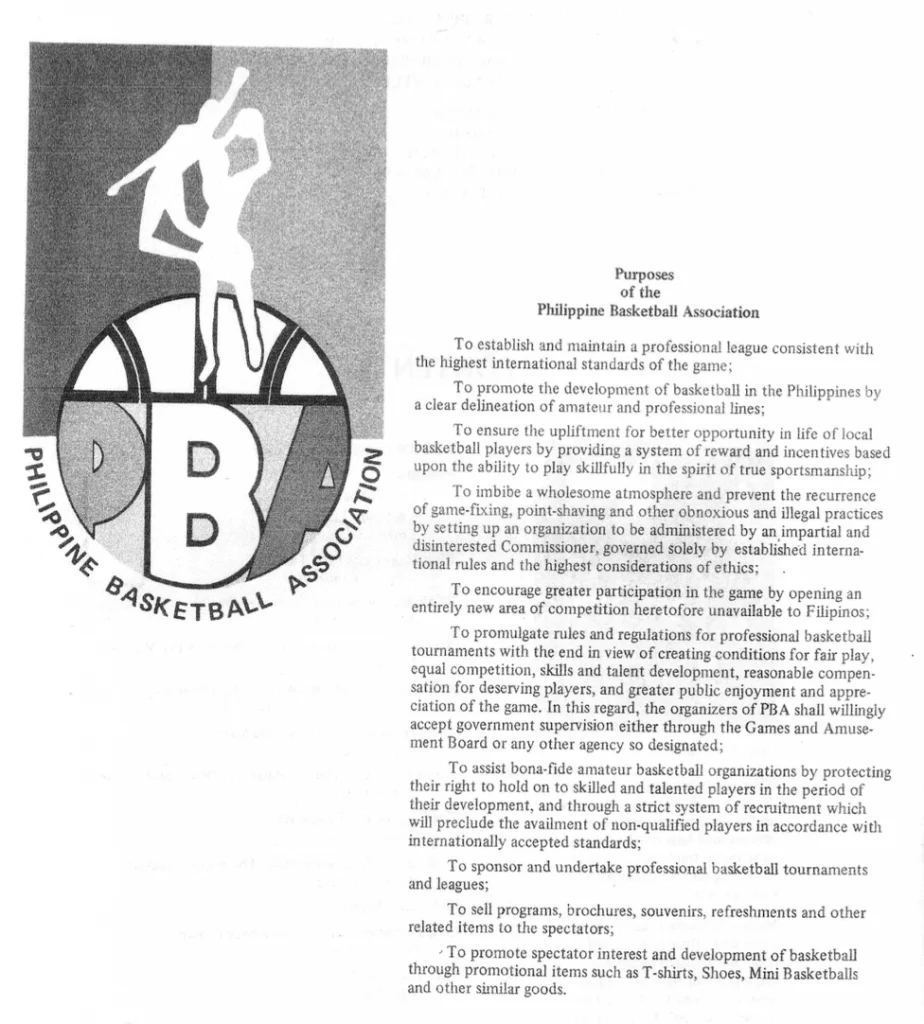
Giant steps
Coseteng didn’t have to worry about who would join the PBA. At least six franchises from the MICAA had signified their intent to join the fledgling league. These were Crispa, Toyota, CFC, Concepcion, U/Tex and Mariwasa. There were other teams who had expressed interest but didn’t give their nod yet.
Joining the PBA later were Tanduay, San Miguel Corporation and Seven-Up. Manilabank, a company owned by the Puyat family and was part of the MICAA, was obviously not included in the list.
For the next couple of months, Prieto worked feverishly to determine the league’s viability. Extensive feasibility studies were done, including market research to determine the fans’ preferences. This also included how many conferences should the league have in one season, the presence of foreign imports, and the tournament format. After many meetings and careful deliberations in a short period of time, the PBA was a go.
Prieto, who also owned the Manila Jockey Club and the international pizza franchise Shakey’s, didn’t let up. Putting his business acumen to full swing, he looked for a suitable office within the Makati business district where he would have three key people initially running the league – a financial analyst, a legal eagle and a public relations officer. Coseteng was then elected PBA President by the Board of Governors made up of the team owners or their representatives.
Initially, the blueprint was to have a two-conference format featuring nine teams in a double-round robin elimination format that would take 45 games per conference for a total of nine months. There would be a one-month rest in between the two conferences. But Prieto opted to have a short one-month 3rd Conference called the All-Philippine Championship to be participated in by the top four teams of the first two conferences.
It was also initially planned to have an All-Filipino format in the first conference. But given the lack of parity among the teams with Crispa, Toyota, U/Tex and Royal Tru Orange cornering the best talents, the league allowed Mariwasa (using the name Noritake) to secure the services of their MICAA resident import, Israel “Cisco” Oliver. After the first round of the first conference, the league then allowed all teams to have one import beef up their squad.
Pros and cons
Forming the PBA wasn’t exactly easy sailing as the league needed to have the players buy into the plan. There was a looming risk as it seemed that the players’ contracts drafted by the PBA seemed to favor management more. The Board agreed that the salaries of the players would range between Php 1,000 to 2,000. Ultimately, the Board decided to discard the pay ceiling and allow the team owners to negotiate directly with the players. U/Tex, for one, was willing to give its players, led by superstars Danny Florencio, Rudy Kutch and Larry Mumar, Php 3,000 a month each. Toyota’s Dante Silverio was even more generous, as sources that time were saying Silverio earmarked an annual budget of Php 60,000 for its 12 players.
There was also the issue of endorsements. The team would get a percentage of what a player would receive from commercial appearances. Prieto believed that since the team takes care of the player, they should be entitled to a 10% agent fee. This didn’t become too much of a problem though as majority of the owners allowed their players to receive their full take.
Another ticklish issue to be dispensed with was the provision that stated that teams could fire a player midway into the tournament if he was suspected of game-fixing, thereby rescinding his contract immediately. The players were obviously wary of these conditions given that these were disadvantageous to them.
Prieto dispelled the notion. He explained that a player’s contract was renewable every year, meaning if a person performed well, then he could demand for an increase in pay. And given that there was no salary cap, the player could demand for any amount he desired. The hitch though was that if a team balked at the price the player asked for, then he would be released to free agency with the risk of having no teams acquiring his services.
Another nagging issue that Prieto needed to settle was the salary of the imports. The Board agreed not to impose a cap on a foreigner’s salary – which meant that it was possible for an import to receive at least 10 times as much as their local counterpart. “How can you tell a local superstar, for example, that he has to play like (Kareem Abdul) Jabbar to merit such compensation? He will never understand it. He’ll think that he’s just plainly being shortchanged.” Given though the quality of imports that were coming in, several of these being NBA veterans and draftees, that concern never saw the light of day.
- Spiking popularity: Comparing volleyball’s following in the Philippines and the US
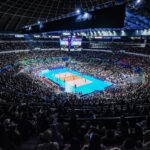
- Cool sweep: How Creamline’s winning formula led to a 7th PVL crown
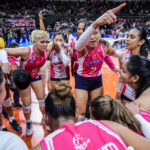
- Pampanga Dragons celebrate 25th anniversary of MBA championship
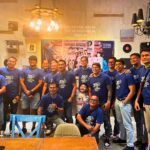
- NBA app launches personalization features, live game experience

- Dante Silverio celebrates 86th birthday in style
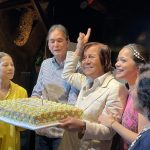
The big day
It was a Wednesday on a holiday, the Fall of Bataan, April 9, 1975, when the PBA opened itself to the public. At least 15,000 fans came to watch the opening day hostilities in anticipation of the newest sporting spectacle in town. As expected, the PBA didn’t scrimp as they made sure that fans would get their money’s worth.
The opening ceremony kicked things off with sultry singer Norma Ledesma singing the national anthem. Then, fans saw all nine teams parading inside the Araneta Coliseum, bringing along their respective muses. Crispa brought in Reggie Prada, Toyota had Lolit Imperial, U/Tex ushered in 1974 Bb. Pilipinas winner Guada Sanchez, Royal Tru Orange featured Marilou Valeriano, Tanduay welcomed Maricita Catibayan, 7/Up tagged Ms. Chinatown 1974 Arlene Cheng, CFC presented actress, model and beauty queen Jean Saburit, Mariwasa had Debbie Enriquez, and Concepcion Industries had Ms. Finland Jhoanna Raunio who represented her country in the 1974 Ms. Universe pageant held in Manila. Coseteng declared the tournament open afterwards as the first twinbill of the PBA was set to unfold.
In the first game, Oliver drilled in 48 points to lead the Porcelain Makers to a 101-98 win over the Carrier Weathermakers. Jun Papa added 17 while Hubert Filipinas chipped in 14 to give the Coseteng franchise its first victory. Carrier had Jimmy Noblezada leading the scoring parade with 24 markers, followed by Jimmy Mariano’s 17, while Boy Mora, Lim Eng Beng and Gene Lucindo added 13 apiece. Joy Dionisio, who made history by scoring the first two points in the PBA, contributed 10 in a losing cause.
The second game was much closer, featuring two of the favored teams – Toyota and U/Tex. Displaying their run and gun game in full form, the Comets churned out a 105-101 victory over the Weavers, led by Ompong Segura’s 23 points. He was backstopped by Francis Arnaiz who scored 22, Big Boy Reynoso who added 17, Mon Fernandez and Tino Reynoso with 13 apiece, and Sonny Jaworski with 11 in a balanced effort. The Weavers got their offense from Mumar and Florencio who both contributed 29 points, while Kutch tallied 13.
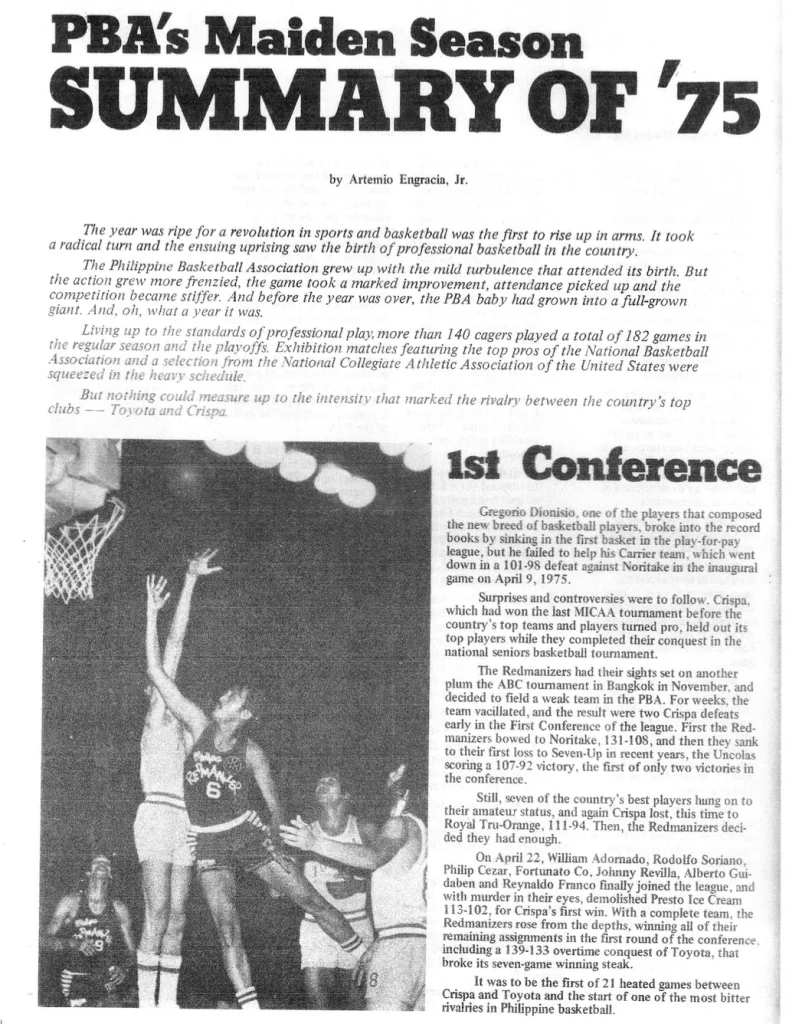
Incomplete Crispa
Curiously, Crispa joined the PBA minus nine of its players. These were Adornado, Guidaben, Atoy Co, Philip Cezar, Freddie Hubalde, Bernie Fabiosa, Rudy Soriano, Johnny Revilla and Rey Franco. Instead, the Redmanizers paraded Bong Dela Cruz, Rey Pages, Jess Sta. Maria, Cris Calilan, Alex Azurin, Eric Leaño, Rey Vallejo, Joel Gomez and Cesar Ijares.
There were a couple of reasons behind this. First, the Redmanizers wanted to finish the National Open tournament where all the winners of various local basketball leagues participated to determine the country’s best basketball ballclub. Crispa eventually won, beating YCO in the finals. Another tournament they wanted to complete in was the National invitationals which they also won, demolishing the top ballclub from South Korea, the Monopoly quintet, 124-101.
At the same time, there was also an apparent deal struck by Crispa owner Danny Floro with Puyat that the Crispa team would represent the Philippines in the 1975 ABC. If they won, the incentive was for them to represent the country once more in the 1976 Montreal Olympics. The condition though, was for the Redmanizers to remain amateur players. The arrangement fell through though as BAP was only willing to have six slots available for the Crispa players, the remaining half to come from the MICAA talents who remained with the league. As such, Floro decided to let the players join their pro team on their fourth game in the PBA. By that time, the Redmanizers were languishing in the cellar with a 0-3 record.
As such, their first meeting with archrivals Toyota, held on May 10 at the jampacked Rizal Memorial Coliseum, resulted in the Redmanizers’ dealing the Comets’ their first loss in the tournament, 139-133, powered by Adornado’s 29 points. Co ably assisted Adornado with 24 while Cezar added 22. Tino Reynoso led all scorers with 32 points, followed by Arnaiz’s 25, Segura’s 22 and Jake Rojas’ 17 points.
Looking forward
The PBA didn’t exactly start seamlessly, especially in the succeeding games when there were blowouts. This forced the league to allow the other teams to bring in an import to help their cause and bring a level of parity. After opening day, there was a perception that the Big Dome wasn’t filled, only to find out later on that the first two weeks of attendance of the PBA was actually better than the first two weeks of attendance of the MICAA in the 1974 season. After a month, 11,000 fans overflowed the Rizal Memorial Coliseum on a Saturday night that saw Crispa and Toyota tangle in their very first PBA match-up.
Prieto was realistic enough to admit that the PBA had so much room for improvement. “It will be rough sailing in the beginning, with everybody asking questions – the players, the coaches, the public, etc. But eventually, given a little time, it will be a success. A professional league is healthy for the sport – especially for the players.”
For the genial Commissioner though, he believed in the PBA’s vision to provide premiere entertainment to the basketball fans. Efforts were made to prevent a duopoly from being cast as Toyota and Crispa dominated the first two seasons of the league. Some teams were allowed to field imports in All-Filipino conferences, leading to Honda and Filmanbank cracking the 1977 and 1978 finals. Also, teams that didn’t perform well the previous season were given opportunities to play two imports of unlimited height at the same time while handicapping the top two performers to field in only one import at a time.
It has been 48 years and the PBA has remained relevant while retaining its title as the top entertainment sports platform in the country. In two years, it will celebrate its 50th golden anniversary. For Coseteng, Prieto and the rest of the Board of Governors in 1975, one can only admire and appreciate the far-reaching vision they established when they formed the league.
